Toad Vigil May 25-7 2016
Martha O'Kennon
For years I have been blaming raccoons for violent attacks twice a summer, when the American toads (Bufo americanus) gather in my backyard pond to mate. Often I will find the whole complement of toads dead in or around the outside of the pond. A couple of weeks ago a massacre f at least ten toads overnight led me to want to make sure that the problem really is the local raccoon population. I posed a question on Researchgate.net as to whether people had information about toads turning violent around the mating process. Syed Abbas Jafar sent in this link about violence in toads
Tatsuo Tabata ventured
the following.
On page 40 of the book "Frogs: The Animal Answer Guide" by Michael E. Dorcas, Whit Gibbons there is a subsection "Do frogs fight?" (see the first link below), and
"We seldom think of frogs as fighting one another, but some species of frog actually use physical combat in social interactions. The large African bullfrog (Pyxicephalus adspersus) is well known for violent fights among males at breeding time."
As for African bullfrog, see this link.
Francesco Nardelli said,
"In my opinion a predator (even a dog or a cat) killed them but felt they are poisonous hence left them. If pressed, I would confirm your first hypothesis."
Elliott R Jacobson , University of Florida, said
"I have never seen frogs or toads of similar size dismember a conspecific such as you describe. Certainly some anurans will feed on others that can fit in their mouth. I vote for a predator, such as raccoons. I have heard (or read) of some predators of toads that avoid their parotid glands when feeding upon them."
I decided to stay up as much as possible to see what was really happening.
Wednesday night, May 25 2016. Albion, Michigan, USA. There are two toads in the pond now. They are currently hiding under some flat submerged stones. It's almost 9:30 pm. The mosquitoes are coming out. OK, now they're starting to trill (they had left off after that last letter.) Oh no, there seem now to be eight of them. They are trying to mount each other but are quickly repulsed. Rather the mountee scurries quickly from under the mounter with a few well-placed words of derision. Too bad the weather has suddenly got quite hot and and humid. The kind of weather that calls the mosquitoes to action. Wish the large female that I almost stepped on yesterday were here now. Now the one nearest me is trilling almost painfully loudly. The mosquitoes seem to be attracted to the laptop (probably because it is warming up.
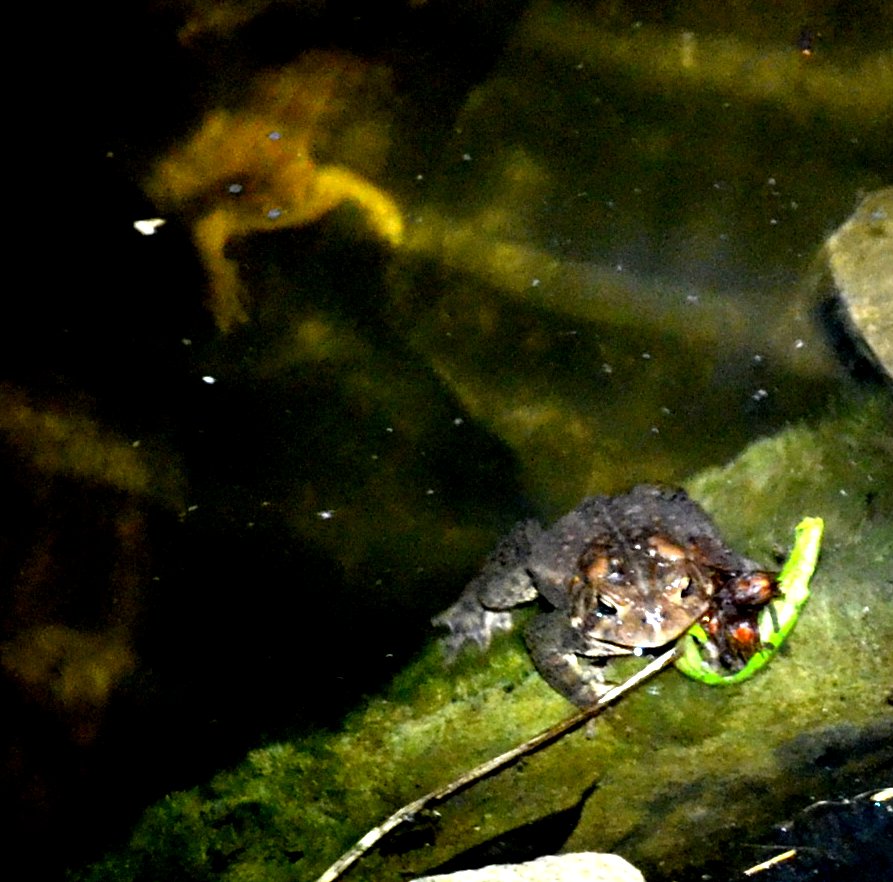
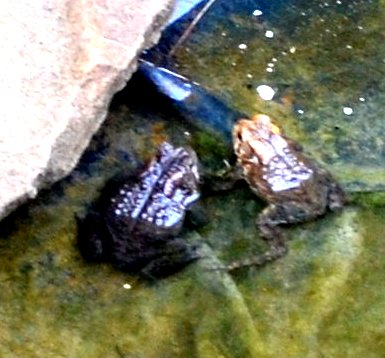
Later.
It's quite dark now except for the living room lamp which I've put out here. The lamp has attracted MANY caddisflies. A few grey tree frogs are to be seen. I like this one looking through a fence slat curiously.
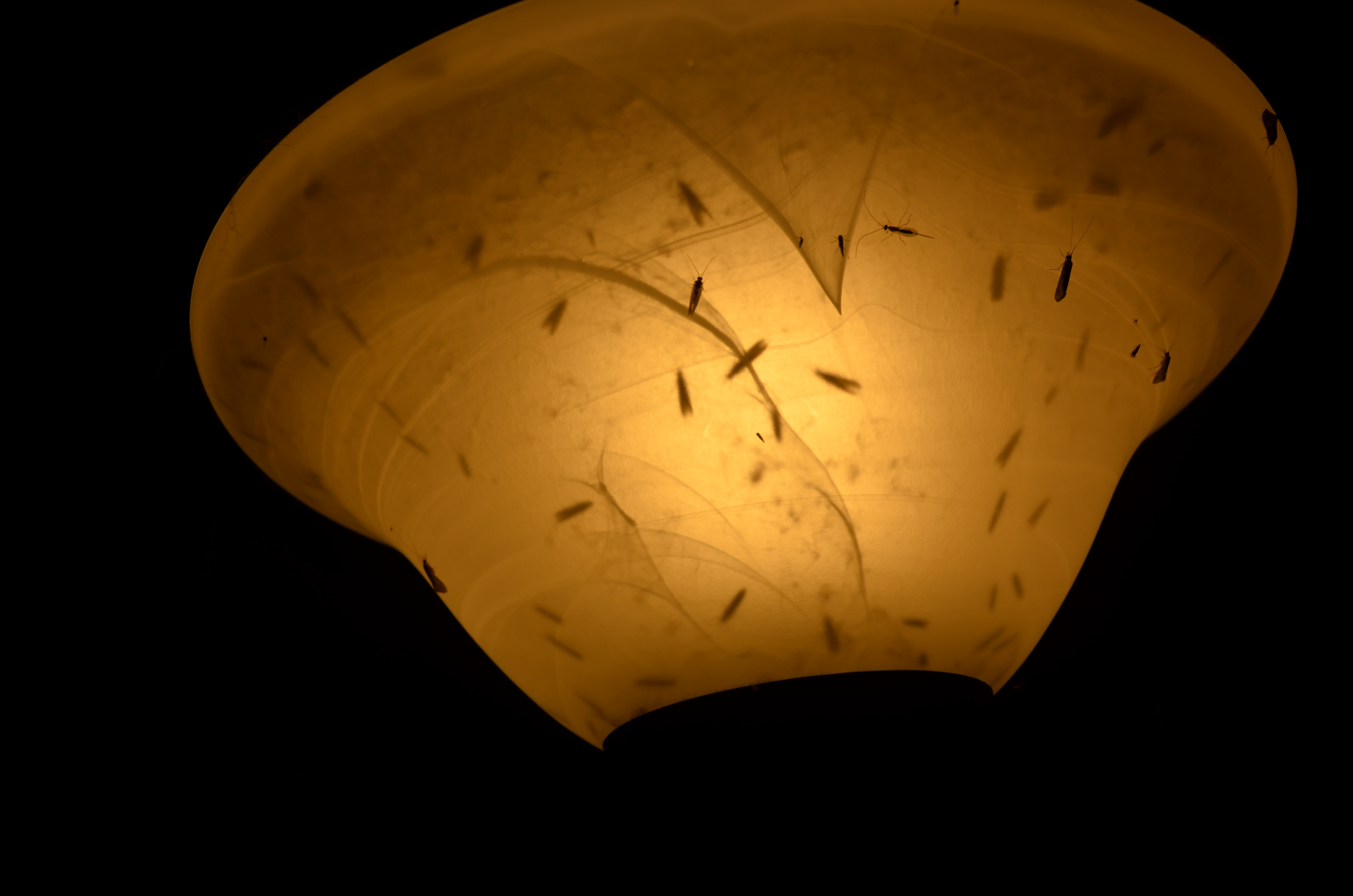
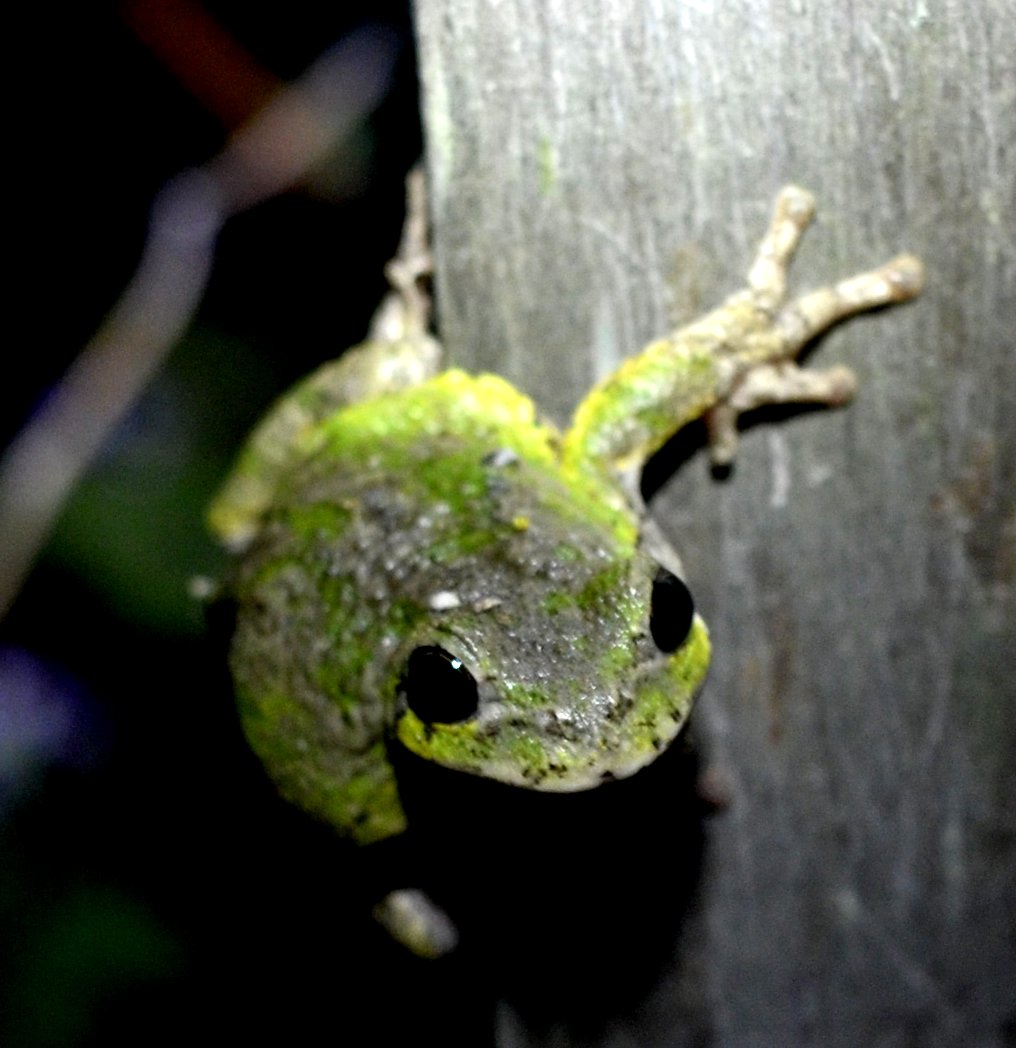
12:10 am.
I'm just about to fall asleep when I hear a heavy object coming toward me. A huge raccoon was leaning into the water about a meter from me with both arms in the pond where one of the toads had been sitting. Instead of grabbing my camera I shouted "Big Raccoon!" The raccoon was out of there like lightning. Analysis: Raccoons attack toads. The smell of a sleeping human doesn't deter them.
12:40 am.
I spread out the leaf net over the pond and secure it with bricks. I don't know what kind of deterrent it will be - the worst is if a female actually comes to the pond and is trapped outside. These raccoons are very pesty. We're no longer allowed to trap one and loose it in the country. (Spread of germs, nuisance value to new "owner".) We can of course shoot it. I'm not prepared to do that. I lugged all my chairs and pillows inside and am now hoping to get a little sleep.
3:30 am
I go down to check on things. It has rained since I was last out. (Should have taken in the lamp!) As suspected, 3 little toads are sitting on top of the net. I have to unpin most of it to get the toads to slip into the water. Some of them get back onto the net. Tip them again. Reassemble the net.
6:30 am, May 26.
Go down to check. No dead toads. Analysis: The toads are quite capable of passing a whole night without killing one another.
One toad looking like a female is trying to get in under the net. I pick her up and put her into the pond.
A little after 7 am on May 26.
Trilling has commenced. A pair seem to be beginning the mating process. You can make out the greenish brown male on top of the pinker larger female. (Ignore the other toad at the top of the first image.)

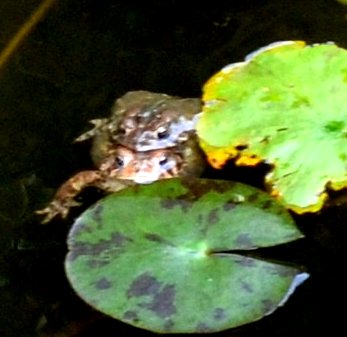
9:00 am.
Can't see the pair that were mating. I'm hoping they are just down at the bottom.
Later in the afternoon.
A lot of muck has been kicked up so it isn't very clear down there. But finally I spot the pair still in amplexus on the bottom of the pond. A lot of muck has been kicked up so it isn't very clear down there.
Bedtime
I put up the netting for the coming night. The male toads seem to be doing a bit of trilling but much less than before.
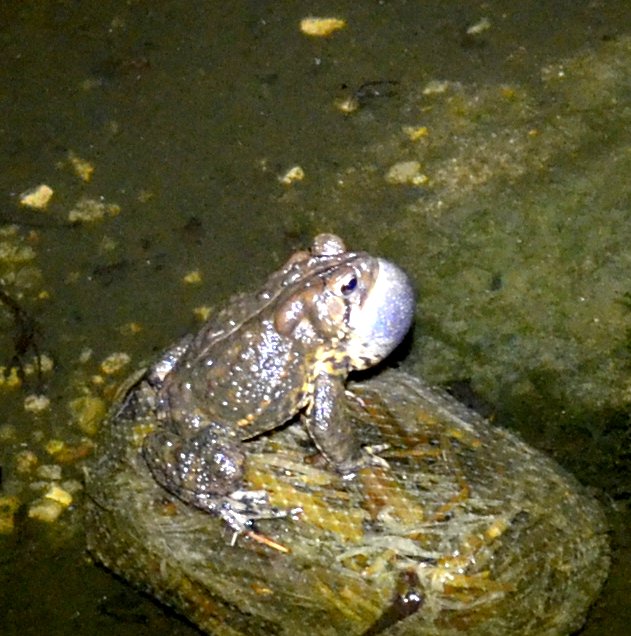 3:00 am.
3:00 am.
One new toad is sitting on top of the net. I pick it up and put it through a convenient hole in the net.
Morning of May 27
The netting is down into the water. Seems likely a raccoon got in and pulled the net in. I find one dead toad just at the edge of the netting, but the rest seem to have escaped from under the net. When the raccoons have massacred the toads in the past, they have always left bodies around uneaten.
Afternoon of May 27
The water has cleared somewhat. But a twisted string of something is wrapped around a lily stem. This is what the strings of eggs covered in protective gel looks like. Look in the lower right quadrant. Actually, here is a better picture of what the egg strands look like. The female toad (with the male on her back with his thumbs poking her abdomen) exudes two strands of eggs and gel. As the eggs emerge, the male fertilizes them. After a few hours the strands assume a fluffy coating over themselves. And in a few days, the eggs hatch into minuscule tadpoles. This last photo was from May 2019.
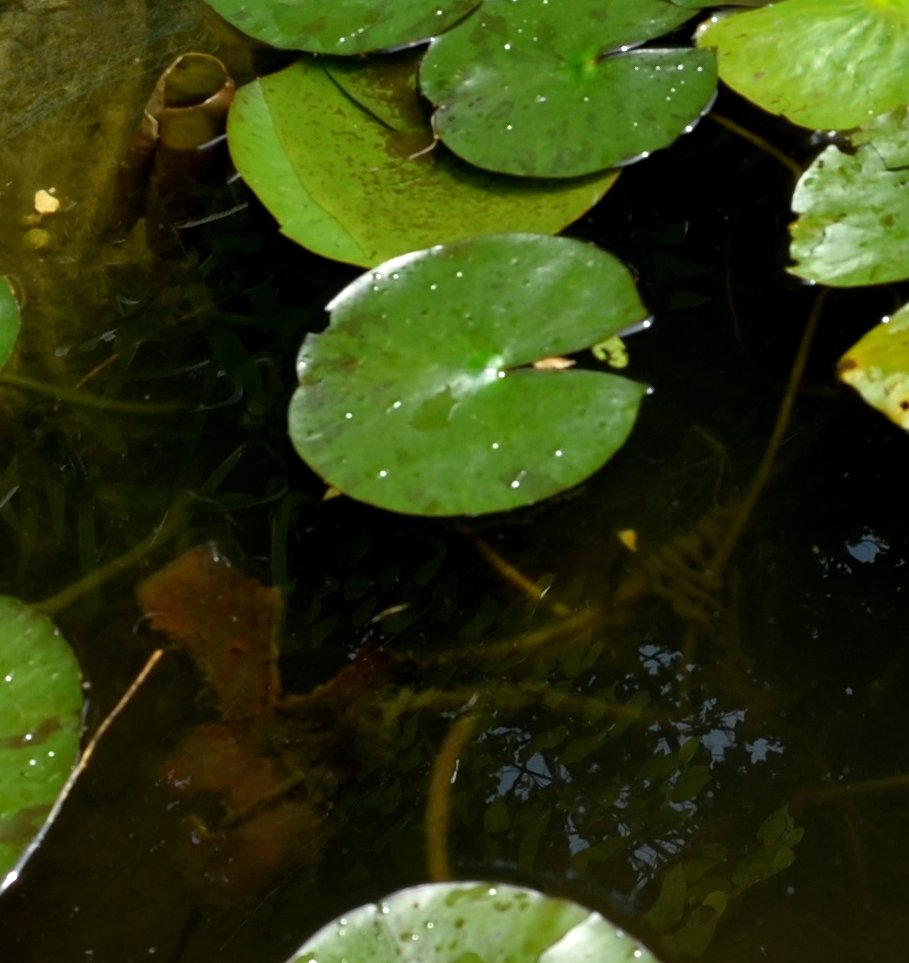

So now we know more about the American toad. It does NOT seem to be particularly mean to its cohort. Raccoons, on the other hand, are quite irrepressible about catching and killing toads who are intent on mating. They do not eat what they kill, but generally leave it in full view. Unless someone shows me otherwise, I will now go back to blaming this mayhem on raccoons.
The following is an account of a very satisfying ingathering of toads in May of 2019.
Toad Ingathering May 2019
Back to main blog menu
copyright Martha O'Kennon 2016








